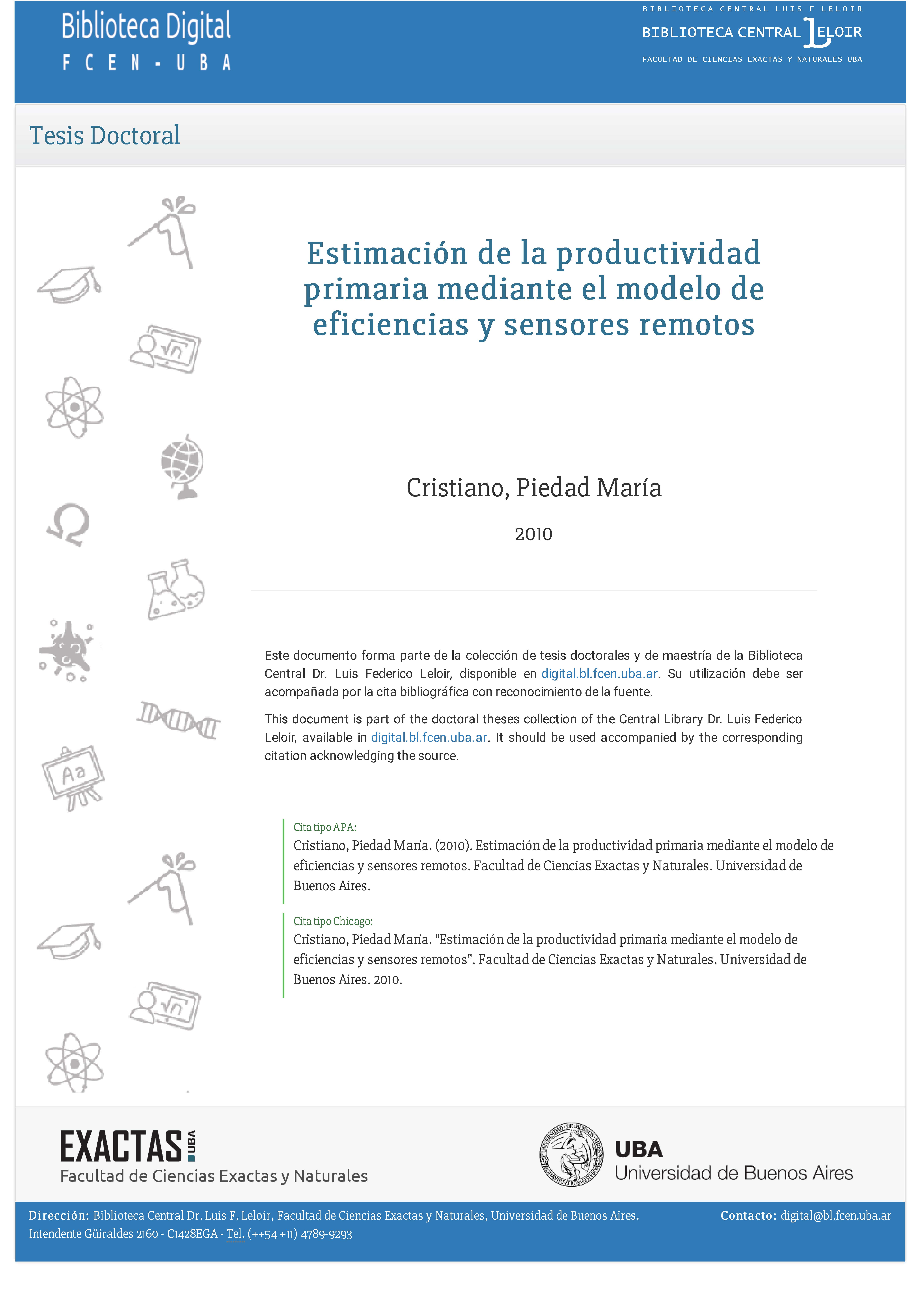Ver ítem
- xmlui.general.dspace_homeCentros e Institutos de InvestigaciónCIRN. Centro de Investigaciones de Recursos NaturalesInstituto de Clima y AguaTesisxmlui.ArtifactBrowser.ItemViewer.trail
- Inicio
- Centros e Institutos de Investigación
- CIRN. Centro de Investigaciones de Recursos Naturales
- Instituto de Clima y Agua
- Tesis
- Ver ítem
Estimación de la productividad primaria mediante el modelo de eficiencias y sensores remotos
Resumen
Uno de los modelos más utilizados para estimar la Productividad Primaria Neta (PPN) a escala regional es el de eficiencias de Kumar and Monteith que permite la inclusión de información satelital. Uno de los parámetros clave es la eficiencia en su utilización (EUR), afectado por los factores de estrés. El objetivo fue mejorar las estimaciones a escala regional de la PPN en pastizales, bajo distintas condiciones de estrés proponiendo una cartografía
[ver mas...]
Uno de los modelos más utilizados para estimar la Productividad Primaria Neta (PPN) a escala regional es el de eficiencias de Kumar and Monteith que permite la inclusión de información satelital. Uno de los parámetros clave es la eficiencia en su utilización (EUR), afectado por los factores de estrés. El objetivo fue mejorar las estimaciones a escala regional de la PPN en pastizales, bajo distintas condiciones de estrés proponiendo una cartografía temática de EUR para la región pampeana, teniendo en cuenta los factores de estrés predominantes (hídrico y nutricional). A través de ensayos manipulativos, se determinaron los cambios en la EUR en 4 gramíneas y en una pastura multiespecífica donde se incluyó el efecto del pastoreo. Para regionalizar los resultados, se generó una cartografía temática de las condiciones hídricas y nutricionales de la región. Para validar este mapa se estimó la PPNA mensual y anual utilizando imágenes MODIS que se compararon con datos de PPNA estimados a campo y con los resultados de otros dos modelos comúnmente utilizados. En los ensayos monoespecíficos la EUR varió entre 2.3-5.2 g/MJ bajo condiciones óptimas de crecimiento y entre 1.02-1.75 g/MJ en las plantas con estrés. En el ensayo multiespecífico, la EUR varió entre 0.63-1.94 g/MJ. La PPNA estimada anual presentó los menores valores en el suroeste de la región (menor a 5800 kg/ha.año) y fue aumentando hacia el noreste hasta alcanzar valores de 14500 kg/ha.año. La validación con datos de PPNA observados y estimados por otros modelos indican que nuestro modelo de EUR variable presenta mayor nivel de ajuste que el de EUR fija.
[Cerrar]
One of the most commonly models used to estimate net primary productivity (NPP) at regional level is that of Kumar and Monteith efficiencies that allows the inclusion of satellite information. One of the key parameters is the radiation use efficiency (RUE), affected by different stresses. The aim was to improve regional estimates of NPP in grasslands under different stress conditions suggesting a thematic mapping of RUE for the Pampas region, taking into
[ver mas...]
One of the most commonly models used to estimate net primary productivity (NPP) at regional level is that of Kumar and Monteith efficiencies that allows the inclusion of satellite information. One of the key parameters is the radiation use efficiency (RUE), affected by different stresses. The aim was to improve regional estimates of NPP in grasslands under different stress conditions suggesting a thematic mapping of RUE for the Pampas region, taking into account the prevailing factors of stress (water and nutrition). Through manipulative experiments, changes in the EUR were identified in 4 grasses and a multispecies pasture where the effect of grazing was included. To regionalize these results, we generated a thematic mapping of water and nutritional conditions of the region. To validate this map, the monthly and annual aerial NPP (ANPP) was estimated using MODIS images. Data were compared with ANPP from field data and the results of two other commonly used models. In monospecific experiments, RUE ranged from 2.3-5.2 g/MJ under optimal growth conditions and between 1.02-1.75 g/MJ in plants under stress. In the multispecies experiment, the RUE varied between 0.63-1.94 g/MJ. The estimated annual PPNA presented the lowest values in the southwestern region (minor than 5800 kg/ha.year) and was increasing towards the northeast to reach values of 14,500 kg/ha.year. The validation results indicate that our variable RUE model presents adjustment higher than the fixed RUE model.
[Cerrar]

Autor
Director de Tesis
Descripción
Tesis para obtener el grado de Doctora en el área de Ciencias Biológicas, de la Universidad de Buenos Aires, en 2010
Fecha
2011-05
Editorial
Facultad de Ciencias Exactas y Naturales, Universidad de Buenos Aires
Formato
pdf
Tipo de documento
tesis doctoral
Palabras Claves
Derechos de acceso
Abierto
 Excepto donde se diga explicitamente, este item se publica bajo la siguiente descripción: Creative Commons Attribution-NonCommercial-ShareAlike 2.5 Unported (CC BY-NC-SA 2.5)
Excepto donde se diga explicitamente, este item se publica bajo la siguiente descripción: Creative Commons Attribution-NonCommercial-ShareAlike 2.5 Unported (CC BY-NC-SA 2.5)


